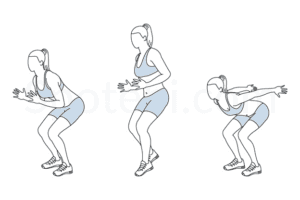The Hidden Benefits of Plyometrics Training

We all know the benefits to staying healthy through exercise. However, knowing what specific exercises are needed to accomplish our goals is often challenging. A quick online search is overwhelming, with results varying from cardio to lifting weights to body weight and stretching exercises. It’s confusing to figure out how each specific exercise will benefit each individual. Through this article, we will discuss one specific style of exercise I find beneficial to all ages and levels – plyometrics!
What are plyometrics?
Plyometrics are defined as an exercise that enables a muscle to reach maximum force in a short amount of time. In essence, it is an attempt to perform a move that puts a muscle in a lengthened, stretched position followed by a quick, forceful contraction of the same muscle in the opposite direction. Most of these movements can be done with body weight alone. Some, more advanced moves might add weights or resistance bands. Think of a muscle as a rubber band. You can quickly pull the rubber band backwards, therefore, lengthening and stretching the band, and then by letting go, it will forcefully go in the opposite direction as it shortens. This is what happens with plyometrics.
The Benefits of Plyometrics
Plyometrics can benefit anybody, not just a high level athlete. By performing plyometric exercises, we can improve overall strength of our muscles, blood flow, flexibility, and reaction time. The ability to improve our reaction time as we age becomes very important as this will directly involve our overall balance and coordination in our home and community. With regards to younger individuals and athletes, plyometrics with explosiveness, agility and responsiveness in their respective sports.
Are Plyometrics for Everybody?
The answer to that is no. Some contraindications to plyometrics would be people with a history of stress related injuries, acute inflammation, joint instability, and post-operative conditions. It is always best to check with a healthcare professional, whether your doctor or licensed physical therapist to make sure that you are appropriate to add plyometrics into your exercise routine.
Three Examples of Plyometric Exercises
As a reminder, make sure you are in good health and/or cleared by a healthcare professional prior to starting these types of exercises.
- Lateral hops

Begin with both feet together, and hop to the side as if you are trying to hop over a line. Land with both feet and then quickly hop back to the starting position. Begin by only hopping a small distance and increase as your ability and confidence increases.
- Jump rope

Jumping rope is a great example of plyometric exercises. Modifications can be made to make it easier or harder including single leg hops, taking intermediate hops, etc. And it is fun!
- Forward hops/shuffle back

Start with both feet together and leap forward like you are hopping like a frog or bunny. Shuffle back with your feet until you are back to your starting position. Increase your distance as your ability and confidence increases.
These are just a few of the many types of plyometric exercises that can be done to help with over muscle strengthening and coordination.
Check with your AzOPT physical therapist to see what type of program would be right for you
References:
https://www.spotebi.com/exercise-guide
https://www.health.harvard.edu/blog










